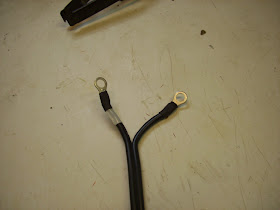Last October I found a centennial 15-91on Albany Craigslist. I had learned, early on, that this particular Singer is a desirable model. I wasn't sure it was a 15-91 from the crappy Craigslist photo. (For more about this go to The Vintage Singer Sewing Machine Blog). I was absolutely thrilled when it turned out to be one.
Something happens to me when I see a sewing machine. All reason disappears and I just fall in love. Really. At 25 bucks this isn't a huge problem. Since I had to make the trip anyway it wasn't as if I was wasting gas. So all in all I was pretty pleased with myself for chasing this machine and nabbing it.
The 15-91 is a gear driven straight stitch machine. According to the user manual it will take up to a size 21 needle. The potted motor on the back houses a spiral gear that meshes with a texolite gear in the handwheel. This direct drive gives added strength and power to the machine. It has a class 15 bobbin and vertical hook. It uses common 15X1 needles that you can get at Wal mart. It runs very smoothly.
I knew that the foot pedal needed re-wiring. I was up to that task for sure. However, I had disassembled this mechanism almost 10 months ago and had no clue which wire was hot and which wire was not. Fortunately I had another foot pedal as a prototype, further supporting my argument that multiple similar sewing machines is an asset.
This is the prototype. I did not do this wiring. I prefer more tidy ( AGAIN!) connections. I followed the wires back to the connection on the three prong stud and labeled the wire that hooked up to the number 1 on the stud (yellow connection) with white tape. Then I lined up my other foot pedal and arbitrarily decided that the wire with writing on it would be the "white" wire and hook up to the number 1 on the stud. IT WORKED.
If you look just above the connection on the right you will see a piece of white tape. That helped me keep it all straight. Please note the tidy connectors. I successfully crimped these. I was not so successful at the other end.
This is AWG 16 wire with SPT-2 jacket. Even though the original wire looked heavier than 18 G on the lamp, it wasn't. I did not have enough 18 G wire to re-wire the foot pedal so I used 16 Gauge. I figured it was safe to use heavier wire than the original. It fit pretty well underneath the housing. The adjuster's manual recommends tying an underwriter's knot. I didn't. http://electrical.about.com/b/2008/10/07/learn-how-to-tie-an-underwriters-knot.htm
At the other end I could not crimp the connectors. I had run out of the nifty little open ended ones (Actually, Steven had run out) and all I had were some heavier ones that were rated for 16 and 14 G wire. I took off the little blue plastic insulators and simply soldered the connectors to the wire.
What a nice neat job. Then I started fretting. The insulators are named such because they insulate. I figured those pretty silver connectors are just like bare wires. I considered snipping and starting over. I only had one connector and to drive to get more requires a fifty mile round trip. The solution; heat shrink stuff. Steven had bought a variety pack for me yesterday and the 1/4 inch fit over the connectors beautifully. I hit it with the hair dryer and take a look. Pretty nice? Note the nice neat white tape.
So that was before lunch. After lunch I set to re-assembling the machine and by 3 PM she was back together. When I had worked on the wiring on the 306K I had made notes about how the wires connect to the three prong stud. I am always amazed when I plug in to the juice and no fuses blow. The light worked and the motor ran. It was a bit sluggish at first, but then it just hummed. No smell, no hesitation, just whirring. What a feeling. WOOO HOOO.
There is more work to do. If you look at the stitch length indicator, the numbers are hard to read. One day I will "paint" these with some acrylic paint. The stitch length lever moves stiffly and despite oiling and applying Tri Flow, I can't get it to move more smoothly. The light needs a total overhaul but since I don't have the glass cover, I may just end up buying a new one. I have an old 66 that has a broken light, so I could use this one on that machine.
I tried this machine out and, you know, it sailed right through 8 layers of heavy canvas, no problem. I made a small envelope bag for it from some scrap canvas I had in the shop. I am not impressed with the way the stitches look. Something is off. That is another day. As is restoring the cabinet. I think I will try the Elixir of Life on it. That is another post.





Somewhat related comment, and a reflection on how far we've come:
ReplyDeleteI have the original sales receipt from 1952 when my grandmother bought a Singer 15-90 40 (what does the 40 mean?) for $204.50. On the section for name, address, etc., there was a section for "color" and the word white was written in. "White?" I thought. "I'm pretty sure this machine was only ever bla--Oh. SKIN color. Yeaaaahh...."
I do not know where this machine is now, but I intend to find out. I was always at Grandma's house and do not recall ever seeing this baby. budding seamstress.